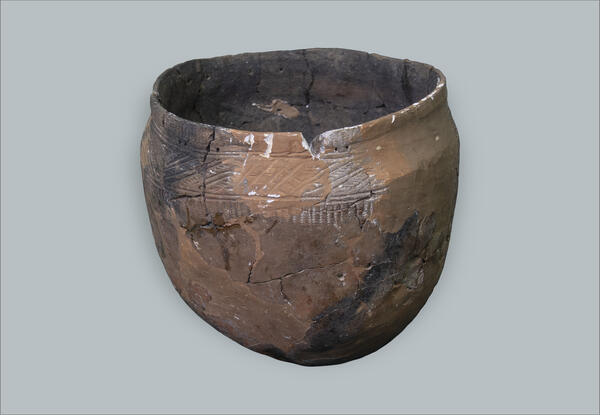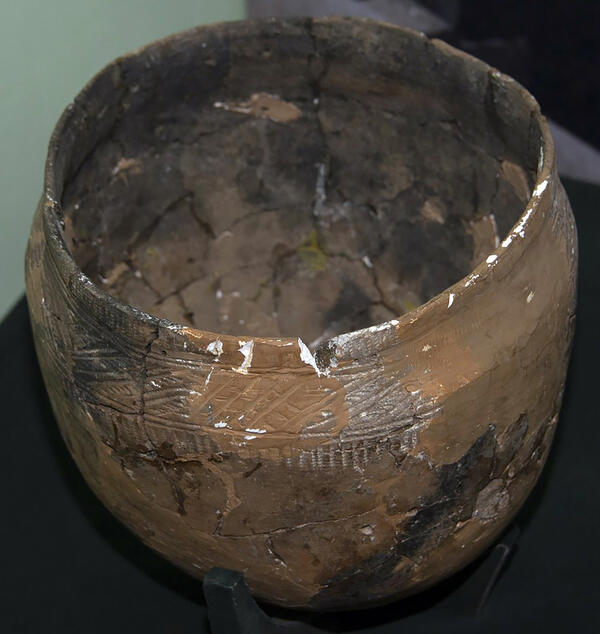In 1967–1974, the first full-scale archaeological survey of Taymir took place. Leonid Pavlovich Khlobystin led the Polar team of the Leningrad branch of the Archaeology Institute of the Russian Academy of Sciences. In the course of the expedition, it was possible to discover more than 300 sites of ancient man and “deepen” the history of the peninsula by about 3,000 years.
The most important and lasting part of the expedition was the study of the Pyasin sites of Dune I–IV with ancient long-term dwellings. The findings revealed that Dune III was the first unique site, testifying to the fact that the population of Western Siberia reached the territory of Taimyr at the end of the first millennium AD. The migrants probably came here with domesticated reindeer and practiced “sedentary reindeer herding”, attracting animals to their dwellings with smoky fires.
A large number of round-bottom pots, ornamented on the shoulders and neck, were found at the sites. One of these items is a pot-shaped vessel on display. In the area of the corolla and shoulders, there is a patterned band made up of alternating rows of scalloped lines and rows of diagonally arranged impressions of small serrated stamps, which form triangular festoons. The band is decorated with vertical scalloped impressions from below and above. Under the corolla, the main ornamental pattern is complemented by a horizontal row of paired pits.
This type of ceramics was described for the first time in 1957 by Valery Nikolaevich Chernetsov, the Soviet archaeologist and ethnographer specializing in Ugrian peoples. He pointed out the similarity of the complex features to those of Karymsky and Orontursky, but at the same time noted its uniqueness in the differently directed shading of triangles and oblique ribbons.
In 1982, based on the finds at the Dune III settlement, Leonid Khlobystin identified an entire archaeological culture, called the Vozhpaisky culture. The exact place of its formation is unknown. According to Khlobystin, it originated in the Ob-Irtysh region and then spread along rivers to the West Siberian circumpolar regions and west of Taimyr.
Some researchers believe that the people of the Vozhpaisky culture were ethnically Samoyedic, and that they are the ancestors of the modern Enets and Nganasans.
The most important and lasting part of the expedition was the study of the Pyasin sites of Dune I–IV with ancient long-term dwellings. The findings revealed that Dune III was the first unique site, testifying to the fact that the population of Western Siberia reached the territory of Taimyr at the end of the first millennium AD. The migrants probably came here with domesticated reindeer and practiced “sedentary reindeer herding”, attracting animals to their dwellings with smoky fires.
A large number of round-bottom pots, ornamented on the shoulders and neck, were found at the sites. One of these items is a pot-shaped vessel on display. In the area of the corolla and shoulders, there is a patterned band made up of alternating rows of scalloped lines and rows of diagonally arranged impressions of small serrated stamps, which form triangular festoons. The band is decorated with vertical scalloped impressions from below and above. Under the corolla, the main ornamental pattern is complemented by a horizontal row of paired pits.
This type of ceramics was described for the first time in 1957 by Valery Nikolaevich Chernetsov, the Soviet archaeologist and ethnographer specializing in Ugrian peoples. He pointed out the similarity of the complex features to those of Karymsky and Orontursky, but at the same time noted its uniqueness in the differently directed shading of triangles and oblique ribbons.
In 1982, based on the finds at the Dune III settlement, Leonid Khlobystin identified an entire archaeological culture, called the Vozhpaisky culture. The exact place of its formation is unknown. According to Khlobystin, it originated in the Ob-Irtysh region and then spread along rivers to the West Siberian circumpolar regions and west of Taimyr.
Some researchers believe that the people of the Vozhpaisky culture were ethnically Samoyedic, and that they are the ancestors of the modern Enets and Nganasans.





